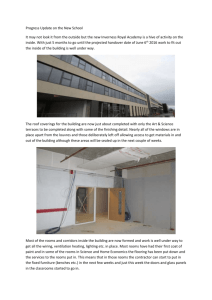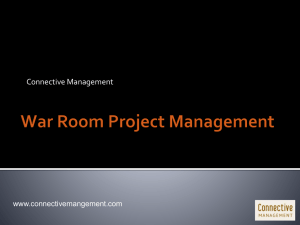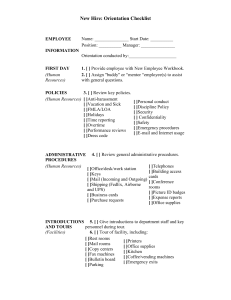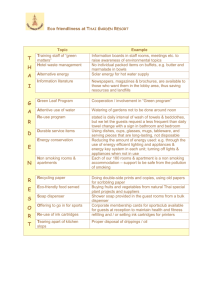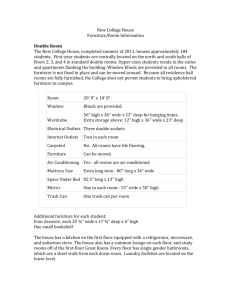Tiny Particles, Big Trouble Lesson Plan
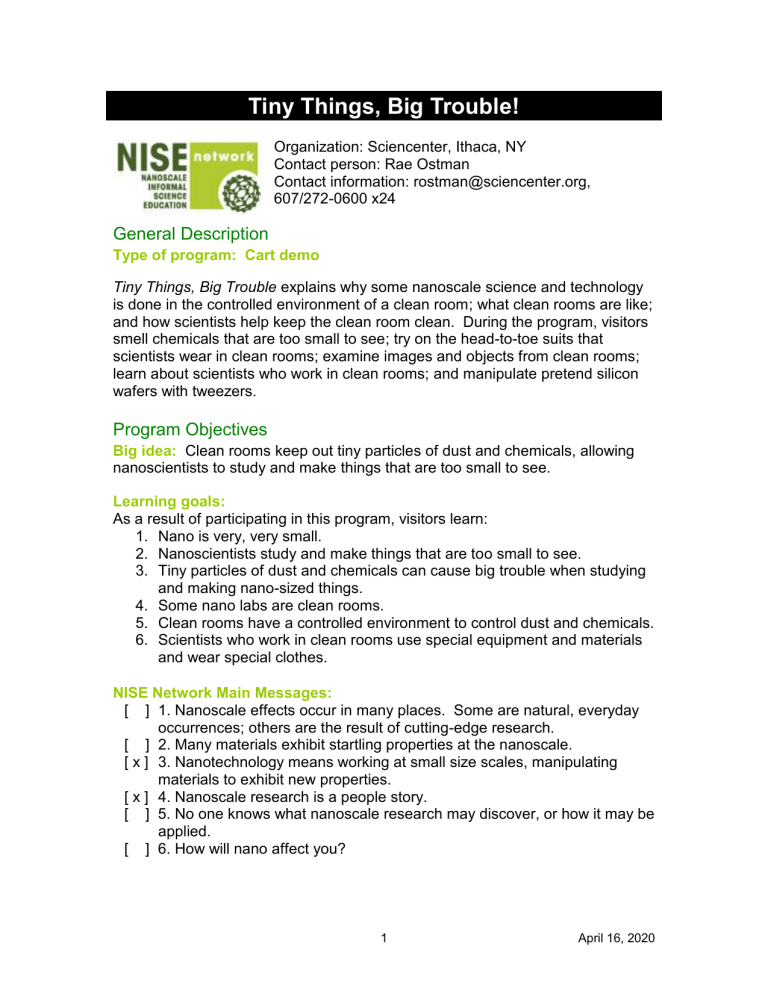
Tiny Things, Big Trouble!
General Description
Organization: Sciencenter, Ithaca, NY
Contact person: Rae Ostman
Contact information: rostman@sciencenter.org,
607/272-0600 x24
Type of program: Cart demo
Tiny Things, Big Trouble explains why some nanoscale science and technology is done in the controlled environment of a clean room; what clean rooms are like; and how scientists help keep the clean room clean. During the program, visitors smell chemicals that are too small to see; try on the head-to-toe suits that scientists wear in clean rooms; examine images and objects from clean rooms; learn about scientists who work in clean rooms; and manipulate pretend silicon wafers with tweezers.
Program Objectives
Big idea: Clean rooms keep out tiny particles of dust and chemicals, allowing nanoscientists to study and make things that are too small to see.
Learning goals:
As a result of participating in this program, visitors learn:
1. Nano is very, very small.
2. Nanoscientists study and make things that are too small to see.
3. Tiny particles of dust and chemicals can cause big trouble when studying and making nano-sized things.
4. Some nano labs are clean rooms.
5. Clean rooms have a controlled environment to control dust and chemicals.
6. Scientists who work in clean rooms use special equipment and materials and wear special clothes.
NISE Network Main Messages:
[ ] 1. Nanoscale effects occur in many places. Some are natural, everyday occurrences; others are the result of cutting-edge research.
[ ] 2. Many materials exhibit startling properties at the nanoscale.
[ x ] 3. Nanotechnology means working at small size scales, manipulating materials to exhibit new properties.
[ x ] 4. Nanoscale research is a people story.
[ ] 5. No one knows what nanoscale research may discover, or how it may be applied.
[ ] 6. How will nano affect you?
1 April 16, 2020
Table of Contents
Tiny Things, Big Trouble!
2 April 16, 2020
Time Required
Set-up Program Clean Up
5 minutes 15 minutes
Background Information
5 minutes
Definition of terms
Nano is the scientific term meaning one-billionth (1/1,000,000,000) It comes from a Greek word meaning “dwarf.”
A nanometer is one one-billionth of a meter. One inch equals 25.4 million nanometers. A sheet of paper is about 100,000 nanometers thick. A human hair measures roughly 50,000 to 100,000 nanometers across. Your fingernails grow one nanometer every second.
(Other units can also be divided by one billion. A single blink of an eye is about one-billionth of a year. An eyeblink is to a year what a nanometer is to a yardstick.)
Nanoscale refers to measurements of 1
– 100 nanometers. A virus is about 70 nm long. A cell membrane is about 9 nm thick. Ten hydrogen atoms are about 1 nm.
At the nanoscale, many common materials exhibit unusual properties, such as remarkably lower resistance to electricity, or faster chemical reactions.
Nanotechnology is the manipulation of material at the nanoscale to take advantage of these properties. This often means working with individual molecules.
Nanoscience, nanoengineering and other such terms refer to those activities applied to the nanoscale.
“Nano,” by itself, is often used as short-hand to refer to any or all of these activities.
3 April 16, 2020
Program-specific background
What is nano?
Researchers and engineers who work in nanoscale science and technology study and make things that are smaller than 100 nm. Nanoscale materials and devices are very, very small
—sometimes they’re built from individual atoms!
Dust and other tiny particles in the environment are huge compared to nanosized things, and can damage them or prevent them from being built or from working. Chemicals in gas form can also harm nano-sized devices.
Computer chips and many other nano-sized devices are built on silicon wafers.
The surface of a silicon wafer is very flat, and may vary by only a few nanometers. Starting from such a smooth base, scientists can build structures that are only a few nanometers tall.
Silicon wafers are made from silicon crystals. To make wafers, engineers grow silicon crystals in cylinders of different diameters, then slice the crystals into thin, round sheets. The wafers have a flat side or a tiny notch that indicates the orientation of the silicon crystal. Wafers come in many sizes. Large, 12-inch wafers are most commonly used in chip manufacture today.
A single computer chip the size of a fingernail can have 20 or more interconnected layers of circuitry. The circuitry can include millions —or even billions —of tiny transistors. (Transistors control the flow of electric current through the chip.) Each transistor can be as small as 45 nanometers across. At that size, 200 million transistors could fit on the head of a pin!
Why work in clean rooms?
Some nanoscale science and technology, such as the fabrication of computer chips, is done in strictly controlled environments called clean rooms . Clean rooms prevent the contamination of nanoscale materials and devices by minute solid particles and airborne chemicals.
Contamination in a lab can come from a number of sources.
The facility itself: construction materials, paints, coatings.
The tools and equipment in the lab: friction and wear particles, lubricants, emissions, vibrations.
The materials used in the lab: chemicals used in research and production, office supplies, cleaning fluids.
The products created in the lab: chips and flakes, debris, chemical offgassing.
The people who work in it: skin flakes and oils, hair, saliva, tears, cosmetics and perfumes, clothing debris.
4 April 16, 2020
Different labs have different levels of cleanliness, measured in the number of particles (0.5 micrometers or smaller) per cubic foot of air. Research labs might be Class 100
—meaning there are no more than 100 tiny particles per cubic foot of air. Industry labs are Class 1
—meaning that there is only 1 particle per cubic foot of air. For comparison, the average house is the equivalent of Class
300,000 —meaning that there are 300,000 particles per cubic foot of air. Some public spaces might be as high as Class 500,000 or even Class 1,000,000!
The only way to minimize the number of particles in the air of a clean room is to control the total environment. Clean rooms are designed with special layouts, systems, and furniture to keep the air clean.
How are clean rooms kept clean?
Air quality is controlled by the design of the lab and by special equipment. Clean rooms are often designed to have slightly positive air pressure
—so that if there are any leaks, clean air will leak out instead dirty air leaking in. Clean rooms are designed to maintain a laminar , or smooth, airflow. The more turbulent the air is, the more particles get stirred up and removed from surfaces. Many clean rooms have a one-way airflow. Filtration systems remove particles from the air and from fluids used in the clean room. Air quality systems monitor and maintain stable temperature and humidity levels.
Special furniture and supplies help to minimize the introduction of particles.
Surfaces and furniture are easy to clean and do not shed particles. They are designed to allow air to flow through and around them so dust doesn’t collect under them. Office and cleaning supplies don’t introduce chemicals, fibers or other contaminants.
Clean room users wear special clothing to minimize contamination. They also follow special protocols and procedures.
To keep dust, dirt, and harmful chemicals out of clean rooms, scientists wear a lot of gear. Hoods, head-to-toe suits, and booties cover their entire body.
Glasses and gloves cover their eyes and hands. All the parts of the suit snap or tape together so they stay in place. In some clean rooms, workers wear masks that cover their entire faces.
Sticky mats are placed all around clean rooms. The adhesive surface of the mat removes dirt from feet and from the wheels of carts. The mats have many layers. Every day the old layer is peeled off, and a new layer is ready to use.
Special supplies are used in clean rooms. Some of these supplies are themselves made in other clean rooms. Sometimes the packaging will indicate what class clean room was used to manufacture the item.
Clean room paper has latex binders to hold the fibers together. It feels different from regular paper, and sometimes is hard to write on.
5 April 16, 2020
Clean room pens use special, lowsodium ink that won’t contaminate the air.
They are made from plastic that doesn’t give off harmful chemicals. No pencils are allowed in clean rooms: they create too much dust.
Swabs and wipes are lintfree, so they don’t release fibers into the air.
Clean room lotion and lip balm keep skin from chapping, so skin flakes won’t fall off. They are made with ingredients that don’t interfere with clean room work.
They come in bottles that don’t release problem chemicals into the air.
Who works in clean rooms?
Researchers and engineers from many different fields work in nano labs and clean rooms. Three scientists are mentioned briefly in the program, to give a sense of the variety of research and fabrication performed in clean rooms.
Tejal Desai is at the University of California San Francisco. Her research group develops biological microelectromechanical systems (bioMEMs) and nanotechnologies for a variety of medical applications:
Cellular integration and tissue engineering, to grow new cardiac and vascular tissue
Biomimetic architectures for functional biomaterials, such as an artificial pancreas to treat diabetes
Therapeutic drug delivery systems that can target specific cells
Antje Baeumner is at Cornell University. Her research group is focusing on developing rapid, inexpensive, easy-to-use, portable, highly-sensitive and reliable biosensors that can detect hazardous biological and chemical substances in the environment, in food and in medical diagnostics.
Baeumner plans to build a device about the size of a cell phone. It would be simple to use, with an on-off switch, a digital readout and an inlet for the sample.
It could detect pathogens such as B. anthracis , C. parvum , dengue virus, and E. coli.
B. anthracis is the bacterium that causes anthrax.
C. parvum is a parasite that causes cryptosporidiosis, a disease of the intestine.
Dengue virus is a mosquito-borne disease that causes a deadly fever.
Some strains of E. coli cause food poisoning.
Stanley Williams is at Hewlett-Packard. He is the head of the Quantum
Science Research Group, which researches and fabricates nanoscale (or
“molecular scale”) electronic, photonic and mechanical devices.
In April 2008, the group reported that they had designed a new device called a memristor that could make it possible to build very dense computer memory chips. These chips would be smaller, would require much less power, and would store a greater variety of memory values than existing memory chips. These
6 April 16, 2020
properties might allow them to imitate biological functions, and could help enable artificial intelligence applications.
Resources
The Cornell NanoScale Science and Technology Facility website has a video tour, a lab user manual, information on the facility and protocols, and course materials from an introductory course on the lab and its capabilities:
www.cnf.cornell.edu/cnf5_videotour.html
www.cnf.cornell.edu/cnf5_labmanual.html
www.cnf.cornell.edu/cnf5_eduoutreach.html
www.cnf.cornell.edu/cnf5_courses.html
Intel’s website includes information on clean rooms and the fabrication of computer chips:
www.intel.com/education.clean room/index.htm
www.intel.com/museum/onlineexhibits.htm
The Stanford Nanofabrication Facility provides an overview on cleanliness and contamination, a lab user manual, and gowning procedures:
snf.stanford.edu/Materials/Contamination/Cleanliness.pdf
snf.stanford.edu/Labmembers/ Labmembers.html
The University of Michigan website provides an overview of their facility:
www.mnf.umich,MNF/About/Facilities.aspx
Wikipedia has information on nanotechnology, clean rooms, computer chips and silicon wafers:
en.wikipedia.org/wiki.Nanotechnology
en.wikipedia.org/wiki.Clean_room
en.wikipedia.org/wiki.Computer_chip
en.wikipedia.org/wiki.Silicon_wafer
Materials
Props are essential to this program! Before you can deliver this program, you’ll need to purchase materials and prepare some of your props. The materials lists and some suggested sources are provided here. For specialty items, suggested items and catalogue numbers are indicated. Preparation instructions are provided in the “Set Up” Section.
Suppliers include
Carolina Biological Supply, www.carolina.com
Life Safety Supply (LSS), www.lss.com
United States Plastic, www.usplastic.com
7 April 16, 2020
VWR, www.vwrsp.com
Dressing activity
Shoe covers, universal size (LSS #966P)
Hooded coverall with boots, size small (VWR #10844-420)
Safety glasses o Children (Carolina #646713) o Adults (Carolina, LSS, VWR, and other suppliers)
Nitrile gloves in two or more colors (LSS, VWR, and other suppliers)
Squeeze bottle activity
Squeeze bottles partially filled with various edible extracts o Bottles and flip tops (United States Plastic) o Edible food extracts, e.g. vanilla extract, anise seed oil, etc.
(grocery stores)
Molecular models of the primary esters (fragrant molecules) in the extracts (optional)
Cleaning wafers demonstration and activity
Petri dishes (Carolina #741248) o Real wafer cases are very expensive, but you can use them if you have them
Laminated images of silicon wafers (link to download photos )
Nitrile gloves (LSS, VWR, and other suppliers)
Plastic tweezers (VWR #47742-558)
Can of compressed gas for dusting electronics (electronics or office supply stores)
Clean room objects for visitors to handle
Sticky mat (VWR #89041-740)
Clean room paper (VWR #47742-558)
Clean room pens (VWR #451280-876)
Clean room wipes (optional —LSS #56918)
Clean room swabs (optional
—LSS #40397)
Clean room lotion (optional
—VWR catalogue #56614-108)
Clean room lip balm (optional —VWR catalogue #14221-444)
Wafer tweezers (optional —VWR catalogue #63042-106)
Images to use during the program (PowerPoint, or printed and laminated):
Computer chip next to a dime
Silicon wafers
Dust on chip
Clean room furniture
Clean room paper and pens
Clean room trash cans
Nanoscientists (Tejal Desai, Antje Baeumner and Stanley Williams)
8 April 16, 2020
Silicon wafers
9 April 16, 2020
Set Up
Time: 5 minutes
Step 1:
Before you can do the program, you’ll need to purchase materials and prepare some of your props. Ordering information is provid ed in the “Materials” section above. Preparation:
Squeeze bottle activity: Fill flip-top, squeezable bottles with edible extracts.
Use at least two different kinds of extracts.
Be sure the extracts are edible (nontoxic).
Don’t overfill the bottles!
To minimize spills and avoid squirts, you can add a cotton ball in each bottle. Use just enough extract to saturate the cotton ball and have a little extra liquid.
Clean wafer demonstration and activity: Make paper wafers and put them in cases.
Find case s for your “wafers.” You can substitute Petri dishes for real wafer cases.
Print the wafer images. Make them ¼ to ½ inch smaller than your cases, so they’ll fit inside after they’re laminated.
Cut out the individual “wafers.”
Laminate the “wafers.”
Trim the laminate close to the edge.
Program images: If you’re using hard copies of the program images (instead of the PowerPoint), print and laminate the images.
Step 2:
Take out all props and images and arrange them in the program area so that they’re handy for use. Make sure that you have everything you need for each demo and activity.
Program Delivery
Time: 15 minutes
Safety:
To avoid allergic reactions, use nitrile or other non-latex gloves.
Tape all four edges of the sticky mat to the floor.
Be sure to use edible (nontoxic) extracts in the squeeze bottles. Advise visitors to keep the squeeze bottles upright and squeeze them gently.
10 April 16, 2020
Use the compressed gas duster with care. Review and follow the safety precautions listed on the can.
Use large, blunt-tipped plastic tweezers (not pointy metal tweezers!).
Procedure and Discussion:
In today’s program, we’re going to learn how tiny particles and chemicals can cause big trouble for researchers working in the fields of nanoscience or nanotechnology.
First, we’ll talk about what nano is.
Next, we’re going to learn why some nano work needs to be done in super clean labs called clean rooms.
Then, we’ll find out what clean rooms are like, and what nanoscientists do in clean rooms to keep tiny particles and chemicals from causing big trouble.
And finally, we’ll learn about the different kinds of scientists who work in clean rooms and what they do.
What is nano?
Has anyone heard of nanoscale science or nanotechnology? Or a nanometer?
Any ideas what these things are?
[Audience response]
Nanotechnology is a field of science and engineering where researchers study and build tiny new materials and devices. They’re so tiny they’re measured in nanometers. Does anyone know how big a nanometer is?
[Audience response]
A nanometer is onebillionth of a meter.
A meter is about as long as the distance from my chin to my hand [hold arm straight out]. Or, if you’re a kid, a meter is about the distance from hand to hand if you hold your arms straight out. Everyone try holding out your arms.
A nanometer is onebillionth of that distance! That’s really small.
To give you a sense of how small that is: Your fingernails grow a nanometer every second! A strand of your hair is about 100,000 nanometers wide.
[Show photo of computer chip and dime and/or pass around computer chip]
11 April 16, 2020
In this photo, you can see a tiny computer chip next to a dime. Look at how small the computer chip is! It’s much smaller than the dime. And it’s made up of parts that are smaller still —so tiny that they’re measured in nanometers.
A chip like this is made of 20 or more layers of circuitry. And the circuitry can include millions —or even billions—of tiny transistors. (Transistors are switches that control the flow of electric current through the chip.) Each transistor can be as small as 45 nanometers across. At that size, 200 million transistors could fit on the head of a pin! So the parts of this chip are very, very small.
Nano is so small that some very ordinary things can interfere and make it impossible to study and make tiny, nano-sized things.
Why do some nanoscientists work in clean rooms?
Computer chips are built in clean rooms, on top of thin, fragile wafers made out of silicon.
[Show photo of silicon wafers and indicate the chips on them]
These are photos of silicon wafers that have lots of tiny computer chips on them.
Each of these little rectangles you see on the wafer is a computer chip, similar to the one we were just looking at.
Who has ever seen tiny dust particles floating in the air?
[Audience response]
Lots of times you can see them when a beam of bright light comes through a window. The air in the rest of the room looks perfectly clean, but it has dust in it, too.
Here in this room, little pieces of dust and other particles in the air are falling on us all the time.
[Show photo of chip with dust]
This is a magnified image of a chip with a piece of dust on it. You can see how huge the dust is compared to the tiny little features on this chip. It could break pieces of the chip, or clog it up so it doesn’t work right.
So dust is one example of a tiny particle that can cause big trouble in a nano lab.
But we can see dust. There are other tiny things in the air that are so tiny we can’t even see them!
Chemicals can float through the air without us being able to see them.
[Hold up squeeze bottles]
12 April 16, 2020
In these bottles, there’s a tiny bit of liquid. Tiny pieces of the liquid evaporate into the air. These pieces, called molecules , are too small for you to see, but you can smell them. Fragrant molecules like these are known as esters .
[Pass around squeeze bottles]
I’m going to pass these around and let you try to figure out what the different food flavorings are that I ’ve put in the bottles. Squeeze them gently and sniff.
Then pass them on to someone else.
So now we know two different, tiny things that can be in the air: particles and chemicals.
Building tiny things like computer chips is really hard and really expensive. It takes a long time and requires special equipment. So nanoscientists have to be very careful while they work.
In order to keep tiny particles and chemicals from messing up their nano work, engineers do some nanoscience and technology in special labs called clean rooms . The environment in clean rooms is controlled very carefully so that the air stays super clean.
Scientists who work in clean rooms wear special clothes, use special equipment and follow special rules that keep the air —and everything else—super clean.
Some clean rooms, like the ones where computer chips are made, are so clean that they have only 1 particle per cubic foot of air! That means that inside a shoebox, there would only be 1 tiny little piece of dust or other particle.
For comparison, this museum might have 500,000 or even 1,000,000 particles per cubic foot of air! So clean rooms really are clean.
Now
I’m going to tell you more about clean rooms, and some of the things scientists do to help keep them clean.
What do scientists wear in a clean room?
To work in a clean room, scientists have to wear special clothes. Why do you think that is?
[Audience response]
Lots of times, when we wear protective clothing it is to protect us from harmful things. For example, fire fighters wear special clothes to protect them from heat and flames. Or, divers wear wet suits to protect them from cold water.
In a clean room, some of the special clothing and equipment is to protect the lab from us !
How could a person contaminate the tiny things that scientists are studying and making?
13 April 16, 2020
[Audience response]
People can bring lots of tiny particles and chemicals into a lab:
Dust and dirt
Hair, little pieces of skin, oils from our skin
Perfume, makeup, and other chemicals
Fuzz and lint from our clothing
Before anyone can enter a clean room, they need to put on protective clothing.
I need a volunteer to show everyone how scientists get ready to go into the clean room. Who’s willing to dress up like you’re going to work in a clean room?
[Choose audience volunteer]
Outside the door of a clean room, scientists put on shoe covers.
[Give volunteer shoe covers to put on]
These cover up their shoes and keep the dirt on their shoes from getting onto the lab floor.
Then, they enter a special room outside the clean room where they get dressed.
But before they enter this “gowning area,” they have to step on a special mat.
[Have volunteer step on sticky mat. Ask volunteer to tell audience how the mat feels.]
The mat is sticky! Why do you think there are special sticky mats like this?
[Audience response]
To remove every trace of dirt, even from brand-new shoe covers! There are sticky mats all over the lab, to pick up tiny pieces of dust and dirt from people’s feet, and from the wheels of carts.
Sticky mats are kind of like lint rollers for your feet!
In the gowning area, scientists get dressed in special suits that cover them from head to toe.
[Give volunteer suit to put on]
Glasses and gloves cover their hands and eyes.
[Give volunteer glasses and gloves to put on]
Once they’re dressed, scientists can enter the clean room. What do you think they step on before they go in?
[Audience response]
14 April 16, 2020
Right! They step on another sticky mat.
[Thank volunteer.]
So, scientists have to wear special clothes to work in a clean room.
How are clean rooms kept clean?
The clean room itself has a special design and special furniture to keep out tiny things that can cause trouble when you’re working on the nanoscale.
Wh at are the two tiny, troublesome things we’ve talked about?
[Audience response]
We’ve talked about:
Particles
Chemicals
Let’s find out how labs keep particles and chemicals to a minimum.
Who can tell me where you find dust bunnies in your house?
[Audience response]
Dust bunnies are usually under big furniture, like under the couch or under the bed.
That’s because the air doesn’t flow freely under big pieces of furniture, so dust gets under them and doesn’t get blown back out.
[Show photo of lab bench]
This is a photo of a clean room table. Notice that the top of the table has holes in it, and the drawers are made of wires. That’s so air can flow through and around it, so dust doesn’t get trapped underneath.
To help keep dust from getting in the lab to begin with, scientists use special supplies.
For example, they use special paper in clean rooms. Paper is made of lots of little fibers. When you rip a regular piece of paper, there’s a ragged edge where you can see those fuzzy little fibers.
Clean room paper is made so it doesn’t shed tiny little fibers. It feels a little bit different from regular paper, because it has special binders to hold the fibers together.
[Pass around clean room paper and pens]
15 April 16, 2020
Here’s some special paper used in clean rooms. You can feel it and also try writing on it. The binder makes it a little bit harder to write on than regular paper.
No pencils are allowed in clean rooms. They make too much dust, so scientists working in clean rooms have to use pens.
Even the pens are special! They have special ink and are made of special plastic. Regular pens have chemicals that could get into the air and interfere with the work being done in the clean room.
There are special air vents and air filters in the lab and on the lab equipment to filter out particles and “scrub” chemicals out of the air.
Some of the materials scientists use in the lab can get into the air. So the filters and scrubbers are very important.
Scientists have to be careful when they work in the lab so that they don’t mess up the work of other scientists. If one scientist uses a certain chemical and a tiny little bit of it stays on a piece of equipment, it could get on something another scientist is making and ruin it. This is called contamination .
Remember the squeeze bottles? Did anyone figure out what kinds of extract I had in there?
[Audience response]
[Identify what was in your bottles; for example:
The red one was cinnamon.
The yellow one was banana.]
The tiny little particles that you can smell look like this.
[Optional: Show molecular models of esters]
Let’s say that cinnamon and banana are two different chemicals we use to make things in a clean room. If the cinnamon molecules get into the air, they can mess up work being done with banana molecules.
So cinnamon and banana have to stay on different sides of the lab. Scientists have to be careful not to take anything with cinnamon on it over to the banana side.
[Put the different kinds of scents on opposite sides of your cart or table]
If I were a scientist working with cinnamon, and I wanted to go over to the banana side of the lab, I would put on new gloves in a different color.
[Show different colored gloves for the “cinnamon” and “banana” areas]
Why would I have to change my gloves? Why would they be a different color?
16 April 16, 2020
[Audience response]
By changing gloves, scientists won’t carry contamination from one area of the lab to the other. The gloves are different colors, which help the scientists remember
(and remind each other) that they need to change them.
Here’s another way clean rooms avoid contamination.
[Show photo of trash cans]
Who can tell me what these photos are of?
[Audience response]
Do you see anything unusual about these trash cans?
[Audience response]
Some clean room trash cans have vents because some of the stuff scientists throw away can have chemicals on them that would get into the air. The hose that’s coming out of this trash can is to vent it.
And some clean room trash cans can only be used for certain kinds of trash.
This trash can is labeled to show what can be thrown away in it.
Clean rooms are organized so that different kinds of work is done in different areas, making contamination less likely. All the scientists who work in clean rooms have to cooperate.
What do scientists do in the lab?
Lots of different kinds of scientists work in nano labs and clean rooms.
[Show photo of featured scientists]
This scientist is named Tejal Desai [Pronounced Teh-JAHL Deh-SIGH]
[Indicate Tejal Desai]
She works at the University of California San Francisco. Her team builds tiny medical devices to cure diabetes, deliver drugs and even grow new heart muscle and blood vessels.
Here’s another scientist. Her name is Antje Baeumner. [Pronounced AHN-cha
BAUM-ner]
[Indicate Antje Baeumner]
She works at Cornell University. Her team is building tiny sensors that can detect pollution and germs.
17 April 16, 2020
Here’s one last scientist.
His name is Stanley Williams.
[Indicate Stanley Williams]
He works at Hewlett-Packard, inventing tiny circuits, switches and other parts for computers and electronics.
Stanley Williams, Tejal Desai, and Antje Baeumner do very different kinds of research, but they all build tiny things in clean rooms as part of their work. What is that like?
Let’s say I’m a scientist who works in a clean room, and I’m building something on a silicon wafer, like this device or the ones we looked at before.
I have to be very careful with it, so that I don’t damage it or contaminate it.
When you hold a CD or DVD, how do you hold it so you don’t scratch it?
[Audience response]
You hold a DVD by the edges (or by the center hole).
Scientists do the same thing with wafers, but wafers are even more fragile than
DVDs, so scientists have to be even more careful.
[Demonstrate how to take a wafer out of a case and clean it]
Step 1: Grasp Step 2: Flip container Step 3: Remove the container so you’re container from above, fingers spaced around the container over, so wafer falls out into your hand holding the wafer by the edges
First, I’m going to take my “wafer” out of its case. I’m going to start by opening the case. Then, I’m going to put my hand over the top of the case and flip it over. That lets the wafer fall into my hand so I’m not touching any part of it except the very edges. Now I’m ready to do something with my wafer.
Any time I want to do work on my wafer, like put it in a piece of equipment, or add a new layer of material to it —I need to clean it. Why?
18 April 16, 2020
[Audience response]
The wafer needs to be clean so that tiny particles and chemicals don’t destroy what I’m making, and so that I don’t get contaminate the equipment for other people.
L et’s say I want to clean the wafer. What should I do? Should I grab a wipe and rub it?
[Audience response]
No —that might scratch the surface or rub away the tiny features on it.
Here’s what I should do:
Hold wafer carefully with tweezers
Blow compressed air over the wafer and toward the tweezers
Why do you think I blow the air toward myself, instead of away from myself?
[Audience response]
It keeps particles and chemicals that might be on the tweezers from blowing onto the wafer
—and all over the rest of the lab.
(In a real lab, scientists do n’t use a can like this. They use a gun that’s connected to a source of compressed nitrogen.)
Recap and Q&A
Thank you for coming to the program!
You can come up and try on a clean room suit, use the tweezers and compressed air to clean the “wafers,” and check out the other clean room stuff I have.
I’m also happy to answer your questions.
But first, who can tell us why clean rooms need to be super clean?
[Audience response]
Because scientists are working with things so tiny that a piece of dust or chemicals in the air could clog them or ruin them!
Tips and Troubleshooting:
Children enjoy the dress-up part of the program and handling all the props. They also like to answer questions and guess the reasons for things. Teens and adults sometimes don’t want to dress up or answer a lot of questions. If you
19 April 16, 2020
don’t have kids in your audience, you might put on the clean room suit yourself, and you might want to present more of the information yourself.
You can substitute local scientists for the ones mentioned in the program.
Common Visitor Questions
Isn’t it uncomfortable and hot to work in the head-to-toe suits?
It can be uncomfortable
—many scientists who work in clean rooms every day say that they don’t get used to them. It’s not hot, though, because the temperature and humidity are carefully controlled.
Doesn’t it take the scientists a long time to get dressed?
They can get dressed quickly because they do it all the time. But, they still have to be sure to allow time to get dressed before their reserved time at the equipment begins.
Why do the lights look yellow in some clean room pictures?
A process called photolithography done in the lab uses ultraviolet light to expose patterns on wafers. The blue in regular white light can interfere with the UVsensitive materials used in photolithography, so yellow lights are used in those areas of the lab. If you take pictures in areas where photolithography is done, you can’t use a flash, because that light will also harm the work.
How often do they change the sticky mats in the lab?
There are lots of sticky mats all over the clean room, and the top layer is peeled off every day.
How often do they wash the suits?
Any time they’re dirty, they must be put in the laundry. Otherwise, scientists can keep them on their hanger to wear again, until the lab puts all the suits into the wash. Some clean rooms do this every day, some every week or two.
How small are the particles that clean rooms keep out?
Clean rooms are rated on their ability to keep out particles 0.5 micrometers and larger. That’s one-half of one-millionth of a meter. You could fit almost 51,000 such particles in an inch.
20 April 16, 2020
Going Further…
Here are some resources you can share with your visitors:
Books
Brezina, Corona. 2007. Careers in nanotechnology. Rosen Publishing.
Jefferis, David. 2006. Micro machines: Ultra-small world of nanotechnology.
Crabtree Publishing.
Johnson, Rebecca L. 2006. Nanotechnology. Lerner Publications.
Maddox, Diane. 2005. Nanotechnology: Science on the edge. Blackbirch
Press.
Wells, Robert E. 1995. What’s smaller than a pygmy shrew? Albert Whitman &
Company.
Internet
The Cornell University website has video tour of their clean room facility:
www.cnf.cornell.edu/cnf5_videotour.html
Intel’s website includes information on clean rooms and the fabrication of computer chips:
www.intel.com/education.clean room/index.htm
www.intel.com/museum/onlineexhibits.htm
Wikipedia has information on nanotechnology, clean rooms, computer chips, and silicon wafers:
en.wikipedia.org/wiki.Nanotechnology
en.wikipedia.org/wiki.Clean_room
en.wikipedia.org/wiki.Computer_chip
en.wikipedia.org/wiki.Silicon_wafer
Clean Up
Time: 5 minutes
Store all materials. Clean and launder props as needed, particularly the suits and glasses. (Tyvek suits can be washed in warm water and air dried.) Restock consumable supplies if necessary.
21 April 16, 2020
Universal Design
This program has been designed to be inclusive of visitors, including visitors of different ages, backgrounds, and different physical and cognitive abilities.
The following features of the program’s design make it accessible:
[ x ] 1. Repeat and reinforce main ideas and concepts
The presentation is organized into discrete chunks.
A content overview is provided at the beginning of the program
(program outline), and the content is summarized at the end of the program.
Learning objectives are repeated throughout the presentation.
[ x ] 2. Provide multiple entry points and multiple ways of engagement
The conte nt is connected to visitors’ prior experiences and knowledge.
Concise key phrases are used to support main ideas.
Main ideas are presented through multiple senses (sight, hearing, smell and touch).
[ x ] 3. Provide physical and sensory access to all aspects of the program
Main ideas are presented through multiple senses (sight, hearing, smell and touch).
Slides are made accessible by using large, high-contrast text and images and by using large, clear fonts.
To give an inclusive presentation of this program:
Make sure your face is visible at all times.
Make sure you doesn’t stand in the way of the slides.
Keep props and models visible when they are relevant.
Pace the program so that visitors can follow the content easily.
Pace the program so that the images, text, speaking and objects don’t compete with each other.
Ask the audience questions, and check in with them along the way to make sure they’re engaged and with you.
Use descriptive language when presenting objects and images.
Make a handout of the presentation available to visitors, either to use during the presentation or to take home.
Make sure your audience knows about any special accommodations you offer.
22 April 16, 2020
This project was supported by the National Science Foundation under Grant No. ESI-0532536.
Any opinions, findings, and conclusions or recommendations expressed in this program are those of the author and do not necessarily reflect the views of the
Foundation.
23 April 16, 2020

